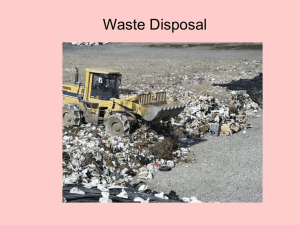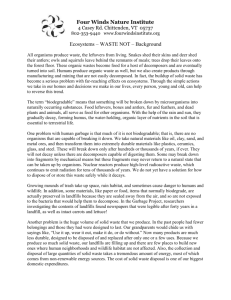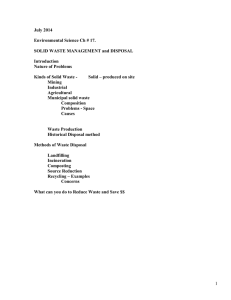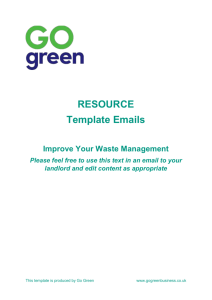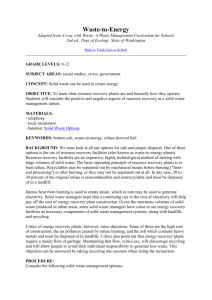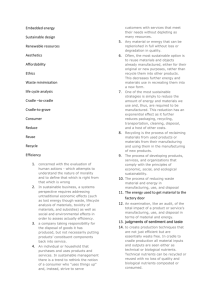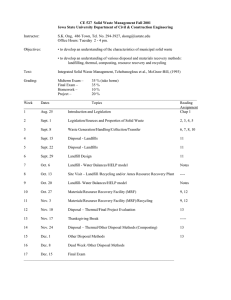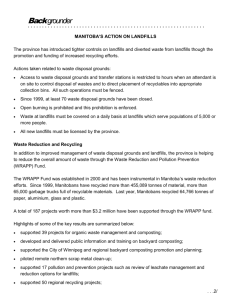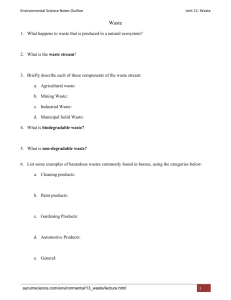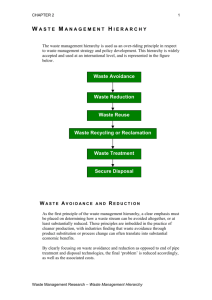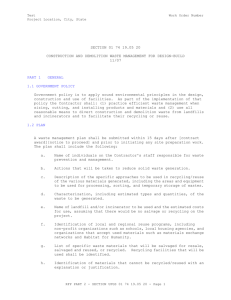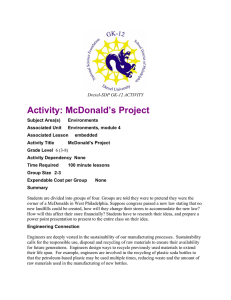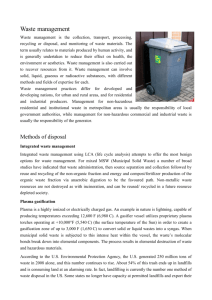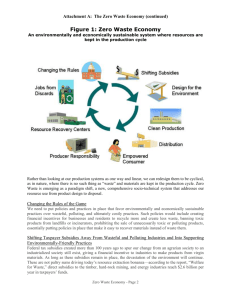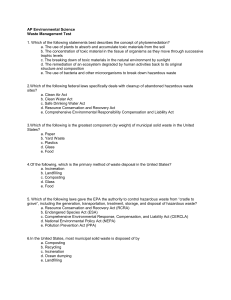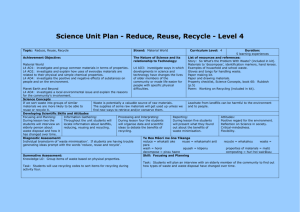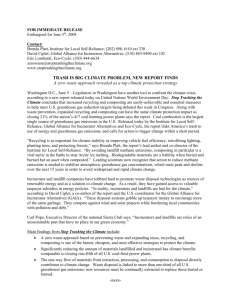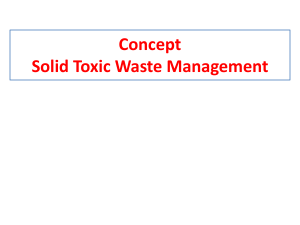CHAPTER 29 NOTES: Primary reason that cell phones aren`t
advertisement
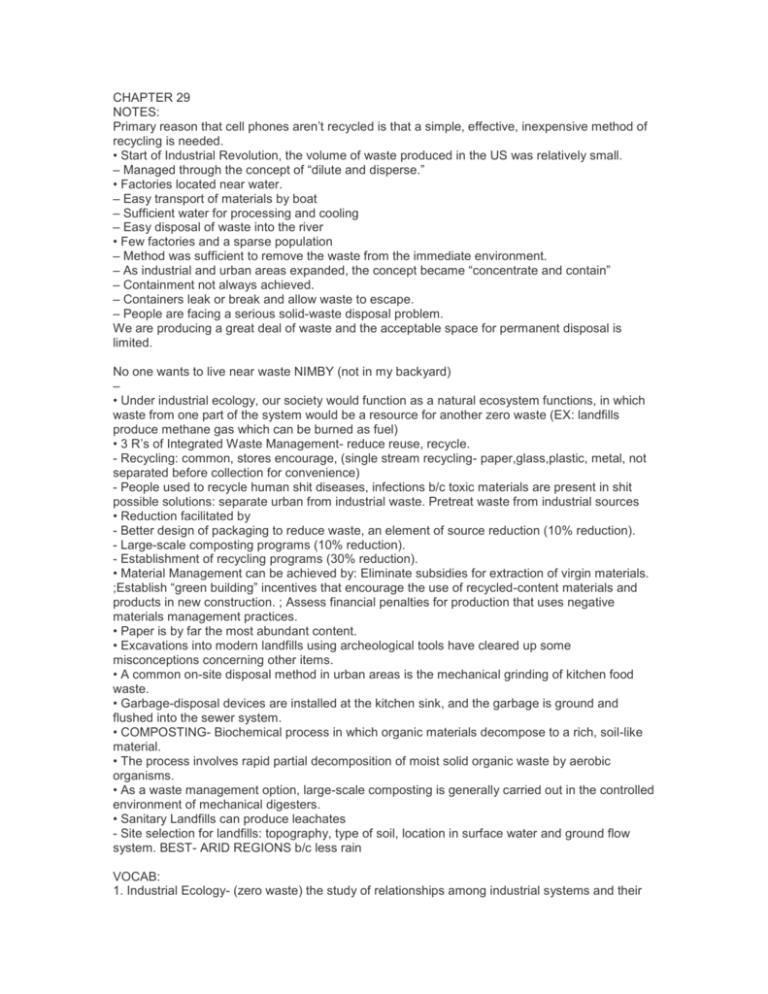
CHAPTER 29 NOTES: Primary reason that cell phones aren’t recycled is that a simple, effective, inexpensive method of recycling is needed. • Start of Industrial Revolution, the volume of waste produced in the US was relatively small. – Managed through the concept of “dilute and disperse.” • Factories located near water. – Easy transport of materials by boat – Sufficient water for processing and cooling – Easy disposal of waste into the river • Few factories and a sparse population – Method was sufficient to remove the waste from the immediate environment. – As industrial and urban areas expanded, the concept became “concentrate and contain” – Containment not always achieved. – Containers leak or break and allow waste to escape. – People are facing a serious solid-waste disposal problem. We are producing a great deal of waste and the acceptable space for permanent disposal is limited. No one wants to live near waste NIMBY (not in my backyard) – • Under industrial ecology, our society would function as a natural ecosystem functions, in which waste from one part of the system would be a resource for another zero waste (EX: landfills produce methane gas which can be burned as fuel) • 3 R’s of Integrated Waste Management- reduce reuse, recycle. - Recycling: common, stores encourage, (single stream recycling- paper,glass,plastic, metal, not separated before collection for convenience) - People used to recycle human shit diseases, infections b/c toxic materials are present in shit possible solutions: separate urban from industrial waste. Pretreat waste from industrial sources • Reduction facilitated by - Better design of packaging to reduce waste, an element of source reduction (10% reduction). - Large-scale composting programs (10% reduction). - Establishment of recycling programs (30% reduction). • Material Management can be achieved by: Eliminate subsidies for extraction of virgin materials. ;Establish “green building” incentives that encourage the use of recycled-content materials and products in new construction. ; Assess financial penalties for production that uses negative materials management practices. • Paper is by far the most abundant content. • Excavations into modern landfills using archeological tools have cleared up some misconceptions concerning other items. • A common on-site disposal method in urban areas is the mechanical grinding of kitchen food waste. • Garbage-disposal devices are installed at the kitchen sink, and the garbage is ground and flushed into the sewer system. • COMPOSTING- Biochemical process in which organic materials decompose to a rich, soil-like material. • The process involves rapid partial decomposition of moist solid organic waste by aerobic organisms. • As a waste management option, large-scale composting is generally carried out in the controlled environment of mechanical digesters. • Sanitary Landfills can produce leachates - Site selection for landfills: topography, type of soil, location in surface water and ground flow system. BEST- ARID REGIONS b/c less rain VOCAB: 1. Industrial Ecology- (zero waste) the study of relationships among industrial systems and their links to natural systems. 2. Integrated Waste Management- a set of management alternatives that includes reuse, source reduction, recycling, composting, landfill, and incineration. 3. Reduce- decreasing the amount of waste produced 4. Reuse- reusing waste as another resource 5. Recycle- to collect and reuse resources in the waste stream 6. Material Management- sustainable use of materials 7. Composting- Biochemical process in which organic materials decompose to a rich, soil-like material. 8. Incineration- burning waste 9. Sanitary Landfill- (municipal solid waste landfill)- concentrates and covers waste to reduce smell 10. Leachate- noxious, mineralized liquid capable of transporting bacterial pollutants 11. Monitoring- taking special samples of water and gas from monitoring wells 12. Secure Landfill- designed to confine waste and control, collect and treat leachate 13. Land application- applying waste to soil 14. Surface impoundment- natural topographic depressions and human made excavations that hold liquid waste 15. Deep-well disposal- injection of waste into deep wells QUESTIONS 1. Yes, by producing waste from food and various other things. It is bad to dump paint thinner down the drain b/c it is toxic to human and animals. 2. Because it can leak out and contaminate water and soil. 3. No, because such facilities should be held far from people 4. On-site disposal is quicker and easier. 5. I think the government should take more action in assuring that waste is disposed safely and citizens should do all that they can to reduce their productions of waste. 6. It is not very safe to swim in them since so much waste has been dumped. 7. Advantages are that we would be reusing waste; disadvantages are that Cox, Sox, and Nox will be produced from incineration 8. Yes I would because it is good for the environment 9. Yes, they should be forces to clean up their waste and dispose it safely 10. I would ask the EPA to examine the waste. If it is toxic, I would move.
